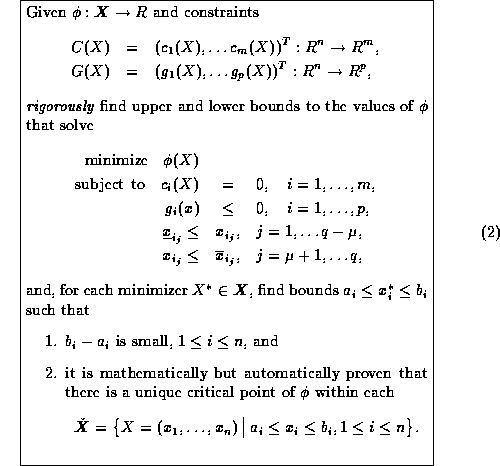
The global optimization problem can be phrased as

Here, the inequality constraints and bound constraints are distinguished. This is because special algorithmic techniques may be used to handle bound constraints. Sometimes, these techniques are more efficient than handling bound constraints as inequality constraints, but this may not be so if there are a large number of bound constraints.
Also note that the bound constraints ![]() and
and
![]() are distinguished from the bounds on the
search region
are distinguished from the bounds on the
search region ![]() . A mathematically-inclined
user can think of a search region limit, say
. A mathematically-inclined
user can think of a search region limit, say ![]() for
some i, as representing an open boundary if i does not
correspond to some
for
some i, as representing an open boundary if i does not
correspond to some ![]() for a bound-constraint, and as being closed
otherwise. If there are no bound constraints or if one or more of
the inequality constraints is infeasible over the entire box
for a bound-constraint, and as being closed
otherwise. If there are no bound constraints or if one or more of
the inequality constraints is infeasible over the entire box ![]() ,
then it is possible that GlobSol will return no answer. However, if
,
then it is possible that GlobSol will return no answer. However, if
![]() is continuous, all search region limits correspond to bound
constraints, and the function is otherwise unconstrained, then GlobSol
must return a global minimum.
is continuous, all search region limits correspond to bound
constraints, and the function is otherwise unconstrained, then GlobSol
must return a global minimum.
Note also that inequality constraints may be transformed into equality
constraints and bound constraints with the introduction of slack
variables. However, this is usually not a good idea in GlobSol. This
is because certainly feasible inequality constraints can be ignored,
whereas equality constraints cannot. (Certainly feasible inequality
constraints are inequality constraints ![]() for which
for which ![]() , where
, where ![]() is the interval extension over the box
is the interval extension over the box ![]() under consideration in the algorithm.)
under consideration in the algorithm.)
Finally, note that a nonlinear system of equations can be solved
by setting ![]() , setting m=n, and setting
, setting m=n, and setting
![]() ,
, ![]() . However, because of the
more complicated structure of the Fritz-John equations (see
§7), it is advisable to use find_roots, rather than find_global_min for
nonlinear systems that do not have additional inequality constraints.
. However, because of the
more complicated structure of the Fritz-John equations (see
§7), it is advisable to use find_roots, rather than find_global_min for
nonlinear systems that do not have additional inequality constraints.